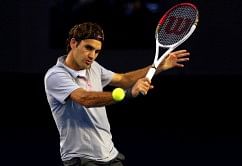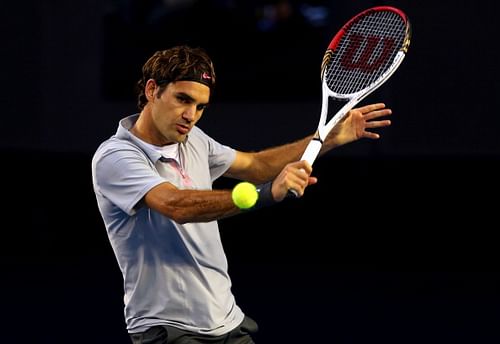
Roger Federer: The will to achieve
One of the most common advertisements that came up (yet again) during Australian Open 2013 is the Rolex commercial, asking “When is greatness achieved?” Roger Federer, the athlete in the advertisement, probably answered the question best at this year’s championships.

Cut back to the day when the draws were announced, and even the most ardent of his critics would have agreed that Roger’s draw was the toughest among the contenders. Davydenko in the 2nd round, Tomic in the 3rd, Raonic in the 4th, Tsonga in the quarters, Murray in the semis, and Djokovic in the final. Surely, it was not possible for the nearly 32-year-old Federer to get past all this. He didn’t. But what he did was more than enough to remind the detractors that he is still good enough to win big tournaments.
It started with Davydenko in the 2nd round. The match between two veterans was a tough one coming in the 2nd round. Davydenko had a good warm up, and had already given Roger a run for his money three years back. But the Swiss kept his temperament, and Davydenko soon started missing his mark and increasing his error count. The final score was 6-3, 6-4, 6-4 in Roger’s favour in less than 2 hours. Next up was Bernand Tomic, who has talked himself up before the match suggesting that he could cause arguably the greatest upset in recent times by ousting Roger so early in the tournament. In his typical style, Roger let his racket do the talking. He won 6-4, 7-6, 6-1. In the next round, Milos Raonic – him of the great serve stature – was taught how much distance he still has to cover before even thinking of being one of the best. The score there read 6-4, 7-6, 6-2. It was not so much the wins themselves, but how the matches were won. Against Raonic, when required to be at his efficient best in order to tackle the huge serve, he only had 12 unforced errors. Against Tomic, when down 4-1 in tie break, he proved his credentials as the greatest tie-break player of all time by turning the tables and winning the tie-breaker. He taught the tennis pundits, fans and critics a lesson that they would not forget in a hurry. These boys of today are still no match for his skills. It can be the grass courts, the clay courts, or the hard courts, but they are all still way behind him. They couldn’t so much as break his serve.
The story was not over. Up against Tsonga, a player against whom he has had some problems in past, he was pushed. Broken for the first time in the tournament, he struggled a bit with his serves and had to win two tie breakers to force a 5th deciding set. However, here is where he proved his genius and broke Tsonga for a 3-1 lead which ultimately proved decisive. The 3 hour, 34 mins match proved that, unlike yesteryears, Roger has to fight to stay afloat in the second week of the tournament. And he was willing to do it.
 The Murray match was one that the whole tennis world watched in awe. The new Murray, with his aggressive play, wore out Roger Federer in five tough sets. However, my opinion is a little different. What I saw was Andy Murray – at the peak of his game and fitness – having to play five long sets for four long hours to overcome an error-prone, poor serving and definitely tired Roger Federer. If Murray had lost this match, most people would have wondered how he managed to lose – such was the difference in their form that day. But Roger fought on. He was broken early in the first set, and was facing a deuce or break points every second game throughout the match. He broke Murray’s serve for the first time in the fourth set. Yet, the will to win was more evident than ever. His forehand and his serve – his two crucial weapons – deserted him. You could have counted on fingers the number of winners he produced with either one of the two. A small mistake in the second set tiebreak – that of going to the wrong side while hitting a volley – cost Murray the set. A very small mistake against an out-of-sorts Roger is all it took. Broken at 6-5 in fourth set, Roger might have started planning his flight back to Switzerland; but he fought on, sending a punishing backhand winner at 30-30 that signalled his intent to push the match into the decider. In the tie break, he made the move by breaking Murray’s serve twice by aggressively moving across and attacking them with huge forehands. That he went off the boil in the fifth set was partly due to fatigue caused by playing back to back tough five setters, four of which were tie breakers.
The Murray match was one that the whole tennis world watched in awe. The new Murray, with his aggressive play, wore out Roger Federer in five tough sets. However, my opinion is a little different. What I saw was Andy Murray – at the peak of his game and fitness – having to play five long sets for four long hours to overcome an error-prone, poor serving and definitely tired Roger Federer. If Murray had lost this match, most people would have wondered how he managed to lose – such was the difference in their form that day. But Roger fought on. He was broken early in the first set, and was facing a deuce or break points every second game throughout the match. He broke Murray’s serve for the first time in the fourth set. Yet, the will to win was more evident than ever. His forehand and his serve – his two crucial weapons – deserted him. You could have counted on fingers the number of winners he produced with either one of the two. A small mistake in the second set tiebreak – that of going to the wrong side while hitting a volley – cost Murray the set. A very small mistake against an out-of-sorts Roger is all it took. Broken at 6-5 in fourth set, Roger might have started planning his flight back to Switzerland; but he fought on, sending a punishing backhand winner at 30-30 that signalled his intent to push the match into the decider. In the tie break, he made the move by breaking Murray’s serve twice by aggressively moving across and attacking them with huge forehands. That he went off the boil in the fifth set was partly due to fatigue caused by playing back to back tough five setters, four of which were tie breakers.
Remember, Federer is not used to this style of play. Fighting for every point is a style more suited for the Nadals, the Murrays and the Djokovics. Yet, he struggled along, even abusing Murray once, and the passion and the zeal to win were fully on display.
For a man with the amount of success that he has had, it was humbling to see the desire to win brimming across the face. Having already achieved all that was for the taking, this man still relishes in facing new challenges of emerging talent of Rafa, Nole and Murray in late last decade, or that of Raonic and Tomic these days; the challenge of adjusting to the constantly slowing courts; the challenge of proving every snide “passing of baton” remark wrong; the challenge of proving in every season, every tournament and every match why he is the greatest player of all time.
So, when IS greatness achieved? As the Rolex advert correctly answered- “Maybe it is when you are always asking-What next?”